U–Pb Age and Hf Isotope Geochemistry of Detrital Zircons from Cambrian Sandstones of the Severnaya Zemlya Archipelago and Northern Taimyr (Russian High Arctic)
Abstract
1. Introduction
2. Stratigraphy
2.1. Northern Taimyr
2.2. Izvestia Tsik Island Group
2.3. Severnaya Zemlya Archipelago
3. Methods and Dated Samples
4. Results of Detrital Zircon U–Pb Dating
4.1. Detrital Zircon U–Pb Ages
4.2. Results of Detrital Zircon Lu–Hf Isotopes
4.3. Statistical Comparisons
5. Discussion
6. Conclusions
- The distribution of detrital zircons from the samples collected from northern Taimyr suggests that deposits previously considered Precambrian are actually Cambrian or younger in age.
- Our data, together with the data from Pease and Scott (2009) [19] and Lorenz et al. (2008) [1], strongly suggest that poorly-fossiliferous, metasedimentary rocks of varying metamorphic grades in northern Taimyr are Cambrian and younger in age. Therefore, we can tentatively claim that there are possibly no rocks older than Early Paleozoic in age across the northern part of the Taimyr Peninsula. However, further analyses are required to confirm this statement.
- All dated samples from both northern Taimyr and the Severnaya Zemlya archipelago show similar distributions of detrital zircon U–Pb ages. The late Neoproterozoic to Cambrian ages of younger detrital zircon clusters strongly suggest that clastics were sourced from the Timanian Orogen. Furthermore, the majority of zircons of that age yield a wide range of εHf(t) values, suggesting a mixing between both juvenile and evolved crust. The detrital zircon age population of our studied samples supports a Baltican affinity for the Kara Terrane during the Early Paleozoic.
- The results presented in this study provide new constraints on the paleogeographic evolution of the Russian High Arctic.
Supplementary Materials
Author Contributions
Funding
Acknowledgments
Conflicts of Interest
References
- Lorenz, H.; Gee, D.G.; Simonetti, A. Detrital zircon ages and provenance of the late Neoproterozoic and Palaeozoic successions on Severnaya Zemlya, Kara shelf: A tie to baltica. Nor. J. Geol. 2008, 88, 235–258. [Google Scholar]
- Lorenz, H.; Männik, P.; Gee, D.; Proskurnin, V. Geology of the Severnaya Zemlya Archipelago and the North Kara Terrane in the Russian high Arctic. Int. J. Earth Sci. 2008, 97, 519–547. [Google Scholar] [CrossRef]
- Zonenshain, L.P.; Kuzmin, M.I.; Natapov, L.M.; Page, B.M. Geology of the USSR: A Plate-Tectonic Synthesis; American Geophysical Union: Washington, DC, USA, 1990; Volume 21, 242p. [Google Scholar]
- Vernikovsky, V.A. Geodynamic Evolution of the Taimyr Folded Region; Publishing House of the Siberian Division of RAS: Novosibirsk, Russia, 1996; 202p. (in Russian) [Google Scholar]
- Priyatkina, N.; Collins, W.J.; Khudoley, A.; Zastrozhnov, D.; Ershova, V.; Chamberlain, K.; Shatsillo, A.; Proskurnin, V. The Proterozoic evolution of northern Siberian Craton margin: A comparison of U–Pb–Hf signatures from sedimentary units of the Taimyr orogenic belt and the Siberian platform. Int. Geol. Rev. 2017, 59, 1632–1656. [Google Scholar] [CrossRef]
- Drachev, S.S. Fold belts and sedimentary basins of the Eurasian Arctic. Arktos 2016, 2, 21. [Google Scholar] [CrossRef]
- Drachev, S.S.; Malyshev, N.A.; Nikishin, A.M. Tectonic history and petroleum geology of the Russian Arctic Shelves: An overview. Pet. Geol. Conf. Ser. 2010, 7, 591–619. [Google Scholar] [CrossRef]
- Ershova, V.; Anfinson, O.; Prokopiev, A.; Khudoley, A.; Stockli, D.; Faleide, J.I.; Gaina, C.; Malyshev, N. Detrital zircon (U–Th)/He ages from Paleozoic strata of the Severnaya Zemlya Archipelago: Deciphering multiple episodes of Paleozoic tectonic evolution within the Russian High Arctic. J. Geodyn. 2018, 119, 210–220. [Google Scholar] [CrossRef]
- Metelkin, D.V.; Kazansky, A.Y.; Vernikovsky, V.A.; Gee, D.G.; Torsvik, T. First palaeomagnetic data on the early Palaeozoic rocks from Severnaya Zemlya (Siberian Arctic) and their geodynamic interpretation. Geol. Geophys. 2000, 41, 1816–1820. (in Russian). [Google Scholar]
- Metelkin, D.V.; Vernikovsky, V.A.; Kazansky, A.Y.; Bogolepova, O.K.; Gubanov, A.P. Paleozoic history of the Kara microcontinent and its relation to Siberia and Baltica: Paleomagnetism, paleogeography and tectonics. Tectonophysics 2005, 398, 225–243. [Google Scholar] [CrossRef]
- Bogdanov, N.A.; Khain, V.E.; Rozen, O.M.; Shipilov, E.V.; Vernikovsky, V.A.; Drachev, S.S.; Kostyuchenko, S.L.; Kuzmichev, A.B.; Sekretov, S.B. Tectonic Map of the Kara and Laptev Seas and North Siberia; Russian Academy of Science: Moscow, Russia, 1998. (in Russian) [Google Scholar]
- Gramberg, I.S.; Ushakov, V.I. Severnaya Zemlya—Geology and Mineral Resources; VNIIOkeangeologia: St. Petersburg, Russia, 2000; 187p. (in Russian) [Google Scholar]
- Makariev, A.A. State Geological Map of the Russian Federation. Scale 1:1,000,000 (Third Generation); Sheet T-45–48th. Cheliuskin; VSEGEI Publishing House: St. Petersburg, Russia, 2012; 472p. (in Russian) [Google Scholar]
- Markovsky, V.A.; Paderin, P.G.; Shneider, G.B.; Lazareva, L.N. State Geological Map of the Russian Federation. Scale 1:200,000; Sheet T-47—VI, XI, XII.; T-48—I, VII, VIII, IX, X (Bol’shevik Island); VSEGEI Publishing House: St. Petersburg, Russia, 1999. (in Russian) [Google Scholar]
- Markovsky, V.A.; Paderin, P.G.; Shneider, G.B.; Lazareva, L.N.; Kuz’min, V.G.; Lazurenko, V.I. State Geological Map of the Russian Federation. Scale 1:200,000; Sheet T-47—XVI, XVII, XVIII, XXII, XXIII.; T-48—XIII, XIV, XV, XVI, XVII, XVIII (Bol’shevik Island). Explanatory Note; VSEGEI Publishing House: St. Petersburg, Russia, 1999; 158p. (in Russian) [Google Scholar]
- Bezzubtsev, V.V.; Zalyaleev, R.S.; Sakovich, A.B. Geological Map of Taimyr Mountains, Scale 1:500,000; Explanatory Notes; Ministry of Geology of the Russian Federation (RSFSR): Krasnoyarsk, Russia, 1986; 177p. (in Russian)
- Pogrebitskiy, Y.E.; Shanurenko, N.K. State Geological Map of the Russian Federation. Scale 1:1,000,000; Sheet S-47–49. Explanatory Note; VSEGEI Publishing House: St. Petersburg, Russia, 1998; 230p. (in Russian) [Google Scholar]
- Pogrebitskiy, Y.E.; Lopatin, B.G. State Geological Map of the Russian Federation. Scale 1:1000,000; S-44–46. Explanatory Note; VSEGEI Publishing House: St. Petersburg, Russia, 1999; 249p. (in Russian) [Google Scholar]
- Pease, V.; Scott, R.A. Crustal affinities in the Arctic Uralides, northern Russia: Significance of detrital zircon ages from Neoproterozoic and Palaeozoic sediments in Novaya Zemlya and Taimyr. J. Geol. Soc. 2009, 166, 517–527. [Google Scholar] [CrossRef]
- Morozov, A.F.; Petrov, O.V. State Geological Map of the Russian Federation. Scale 1:2,500,000; VSEGEI Publishing House: St. Petersburg, Russia, 2004. (in Russian) [Google Scholar]
- Cohen, K.M.; Finney, S.C.; Gibbard, P.L.; Fan, J.-X. The ICS International Chronostratigraphic Chart. Episodes 2013, 36, 199–204. [Google Scholar] [CrossRef]
- Kurapov, M.Y.; Ershova, V.B.; Makariev, A.A.; Makarieva, E.V.; Khudoley, A.K.; Luchitskaya, M.V.; Prokopiev, A.V. Carboniferous Granitoid Magmatism of Northern Taimyr: Results of Isotopic-Geochemical Study and Geodynamic Interpretation. Geotectonics 2018, 52, 225–239. [Google Scholar] [CrossRef]
- Stacey, J.S.; Kramers, J.D. Approximation of terrestrial lead isotope evolution by a two-stage model. Earth Planet. Sci. Lett. 1975, 26, 207–221. [Google Scholar] [CrossRef]
- Andersen, T.; Andersson, U.B.; Graham, S.; Åberg, G.; Simonsen, S.L. Granitic magmatism by melting of juvenile continental crust: New constraints on the source of Palaeoproterozoic granitoids in Fennoscandia from Hf isotopes in zircon. J. Geol. Soc. 2009, 166, 233–247. [Google Scholar] [CrossRef]
- Andersen, T.; Elburg, M.A.; Magwaza, B.N. Sources of bias in detrital zircon geochronology: Discordance, concealed lead loss and common lead correction. Earth-Sci. Rev. 2019, 197, 102899. [Google Scholar] [CrossRef]
- Rosa, D.R.N.; Finch, A.A.; Andersen, T.; Inverno, C.M.C. U–Pb geochronology and Hf isotope ratios of magmatic zircons from the Iberian Pyrite Belt. Min. Pet. 2009, 95, 47–69. [Google Scholar] [CrossRef]
- Elburg, M.A.; Andersen, T.; Bons, P.D.; Simonsen, S.L.; Weisheit, A. New constraints on Phanerozoic magmatic and hydrothermal events in the Mt Painter Province, South Australia. Gondwana Res. 2013, 24, 700–712. [Google Scholar] [CrossRef]
- Kristoffersen, M.; Andersen, T.; Elburg, M.A.; Watkeys, M.K. Detrital zircon in a supercontinental setting: Locally derived and far-transported components in the Ordovician Natal Group, South Africa. J. Geol. Soc. 2016, 173, 203–215. [Google Scholar] [CrossRef]
- Slama, J.; Pedersen, R.B. Zircon provenance of SW Caledonian phyllites reveals a distant Timanian sediment source. J. Geol. Soc. 2015, 172, 465–478. [Google Scholar] [CrossRef]
- Beranek, L.P.; van Staal, C.R.; McClelland, W.C.; Israel, S.; Mihalynuk, M.G. Baltican crustal provenance for Cambrian–Ordovician sandstones of the Alexander terrane, North American Cordillera: Evidence from detrital zircon U–Pb geochronology and Hf isotope geochemistry. J. Geol. Soc. 2013, 170, 7–18. [Google Scholar] [CrossRef]
- Andersen, T.; Elburg, M.; Cawthorn-Blazeby, A. U–Pb and Lu–Hf zircon data in young sediments reflect sedimentary recycling in eastern South Africa. J. Geol. Soc. 2016, 173, 337–351. [Google Scholar] [CrossRef]
- Andersen, T.; Kristoffersen, M.; Elburg, M.A. Visualizing, interpreting and comparing detrital zircon age and Hf isotope data in basin analysis—A graphical approach. Basin Res. 2018, 30, 132–147. [Google Scholar] [CrossRef]
- Gardiner, N.J.; Kirkland, C.L.; Van Kranendonk, M.J. The Juvenile Hafnium Isotope Signal as a Record of Supercontinent Cycles. Sci. Rep. 2016, 6, 38503. [Google Scholar] [CrossRef] [PubMed]
- Griffin, W.L.; Wang, X.; Jackson, S.E.; Pearson, N.J.; O’Reilly, S.Y.; Xu, X.; Zhou, X. Zircon chemistry and magma mixing, SE China: In-situ analysis of Hf isotopes, Tonglu and Pingtan igneous complexes. Lithos 2002, 61, 237–269. [Google Scholar] [CrossRef]
- Linnemann, U.; Gerdes, A.; Hofmann, M.; Marko, L. The Cadomian Orogen: Neoproterozoic to Early Cambrian crustal growth and orogenic zoning along the periphery of the West African Craton—Constraints from U–Pb zircon ages and Hf isotopes (Schwarzburg Antiform, Germany). Precambrian Res. 2014, 244, 236–278. [Google Scholar] [CrossRef]
- Cawood, P.A.; Hawkesworth, C.J.; Dhuime, B. Detrital zircon record and tectonic setting. Geology 2012, 40, 875–878. [Google Scholar] [CrossRef]
- Gee, D.G.; Fossen, H.; Henriksen, N.; Higgins, A.K. From the Early Paleozoic Platforms of Baltica and Laurentia to the Caledonide Orogen of Scandinavia and Greenland. Episodes 2008, 31, 44–51. [Google Scholar] [CrossRef]
- G Gee, D.G.; Pease, V. The Neoproterozoic Timanide Orogen of eastern Baltica: Introduction. Geol. Soc. Lond. Mem. 2004, 30, 1–3. [Google Scholar] [CrossRef]
- Andersson, U.B.; Sjöström, H.; Högdahl, K.H.O.; Eklund, O. The Transscandinavian Igneous Belt, evolutionary models. In The Transscandinavian Igneous Belt (TIB) in Sweden: A Review of its Character and Evolution; Special Paper 37; Geological Survey of Finland: Espoo, Finland, 2004; pp. 104–112. [Google Scholar]
- Korja, A.; Lahtinen, R.; Nironen, M. The Svecofennian orogen: A collage of microcontinents and island arcs. Geol. Soc. Lond. Mem. 2006, 32, 561–578. [Google Scholar] [CrossRef]
- Gorbatschev, R. The Transscandinavian Igneous Belt—Introduction and background. In The Transscandinavian Igneous Belt (TIB) in Sweden: A Review of its Character and Evolution; Special Paper 37; Geological Survey of Finland: Espoo, Finland, 2004; pp. 9–15. [Google Scholar]
- Larson, S.å.; Berglund, J. A chronological subdivision of the Transscandinavian Igneous Belt—Three magmatic episodes? Geol. Föreningen Stockh. Förhandlingar 1992, 114, 459–461. [Google Scholar] [CrossRef]
- Bingen, B.; Nordgulen, Ø.; Viola, G.A. Four-phase model for the sveconorwegian orogeny, SW Scandinavia. Nor. Geol. Tidsskr. 2008, 88, 43–72. [Google Scholar]
- Bingen, B.; Van Breemen, O. Tectonic regimes and terrane boundaries in the high-grade Sveconorwegian belt of SW Norway, inferred from U–Pb zircon geochronology and geochemical signature of augen gneiss suites. J. Geol. Soc. 1998, 155, 143–154. [Google Scholar] [CrossRef]
- McLelland, J.M.; Selleck, B.W.; Bickford, M.E. Review of the Proterozoic evolution of the Grenville Province, its Adirondack outlier, and the Mesoproterozoic inliers of the Appalachians. In From Rodinia to Pangea: The Lithotectonic Record of the Appalachian Region; Geological Society of America: Boulder, CO, USA, 2010; Volume 206, pp. 21–49. [Google Scholar]
- Pedersen, S.; Andersen, T.; Konnerup-Madsen, J.; Griffin, W.L. Recurrent mesoproterozoic continental magmatism in South-Central Norway. Int. J. Earth Sci. 2009, 98, 1151–1171. [Google Scholar] [CrossRef]
- Rivers, T. Assembly and preservation of lower, mid, and upper orogenic crust in the Grenville Province—Implications for the evolution of large hot long-duration orogens. Precambrian Res. 2008, 167, 237–259. [Google Scholar] [CrossRef]
- Andersen, T. Crustal Evolution in the SW Part of the Baltic Shield: The Hf Isotope Evidence. J. Petrol. 2002, 43, 1725–1747. [Google Scholar] [CrossRef]
- Andersen, T.; Griffin, W.L.; Sylvester, A.G. Sveconorwegian crustal underplating in southwestern Fennoscandia: LAM-ICPMS U–Pb and Lu–Hf isotope evidence from granites and gneisses in Telemark, southern Norway. Lithos 2007, 93, 273–287. [Google Scholar] [CrossRef]
- Brusnitsyna, E.A.; Ershova, V.B.; Khudoley, A.K.; Andersen, T. Age and Provenance of the Mesoproterozoic-Lower Neoproterozoic Strata of the Chetlass Stone (Timan Range): Constraints from U–Pb Detrital Zircon Study. Abstract book. In Proceedings of the International Conference on Arctic Margins (ICAM), Stockholm, Sweden, 11–14 June 2018. [Google Scholar]
- Kuznetsov, N.B.; Natapov, L.M.; Belousova, E.A.; O’Reilly, S.Y.; Griffin, W.L. Geochronological, geochemical and isotopic study of detrital zircon suites from late Neoproterozoic clastic strata along the NE margin of the East European Craton: Implications for plate tectonic models. Gondwana Res. 2010, 17, 583–601. [Google Scholar] [CrossRef]
- Ershova, V.B.; Lorenz, H.; Prokopiev, A.V.; Sobolev, N.N.; Khudoley, A.K.; Petrov, E.O.; Estrada, S.; Sergeev, S.; Larionov, A.; Thomsen, T.B. The De Long Islands: A missing link in unraveling the Paleozoic paleogeography of the Arctic. Gondwana Res. 2016, 35, 305–322. [Google Scholar] [CrossRef]
- Ershova, V.B.; Ivleva, A.S.; Podkovyrov, V.N.; Khudoley, A.K.; Fedorov, P.V.; Stockli, D.; Anfinson, O.; Maslov, A.V.; Khubanov, V. Detrital zircon record of the Mesoproterozoic to Lower Cambrian sequences of NW Russia: Implications for the paleogeography of the Baltic interior. GFF 2019, 1–10. [Google Scholar] [CrossRef]
- Amato, J.M.; Toro, J.; Miller, E.L.; Gehrels, G.E.; Farmer, G.L.; Gottlieb, E.S.; Till, A.B. Late Proterozoic–Paleozoic evolution of the Arctic Alaska–Chukotka terrane based on U–Pb igneous and detrital zircon ages: Implications for Neoproterozoic paleogeographic reconstructions. Geol. Soc. Am. Bull. 2009, 121, 1219–1235. [Google Scholar] [CrossRef]
- Lorenz, H.; Gee, D.G.; Korago, E.; Kovaleva, G.; McClelland, W.C.; Gilotti, J.A.; Frei, D. Detrital zircon geochronology of Palaeozoic Novaya Zemlya—A key to understanding the basement of the Barents Shelf. Terra Nova 2013, 25, 496–503. [Google Scholar] [CrossRef]
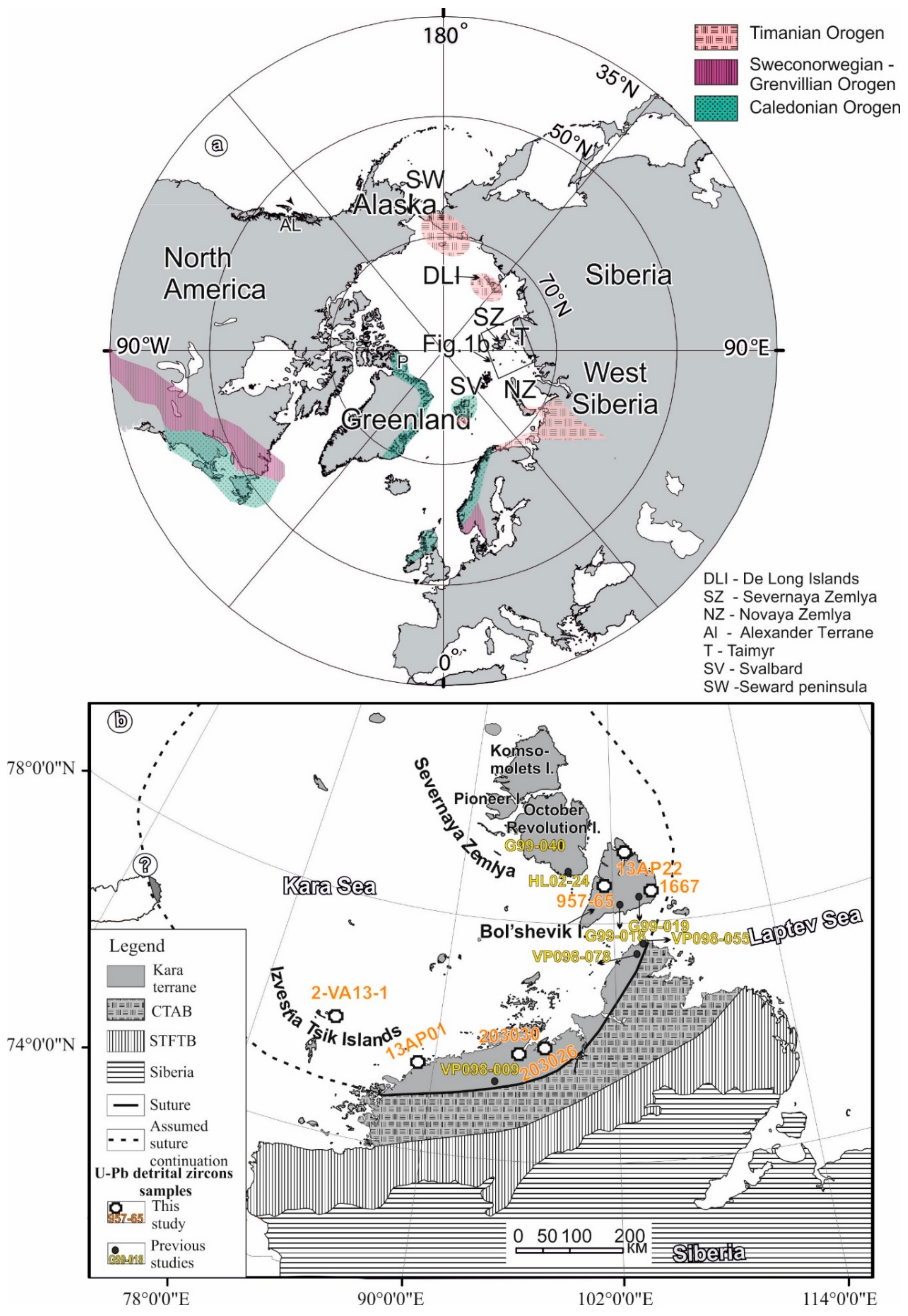
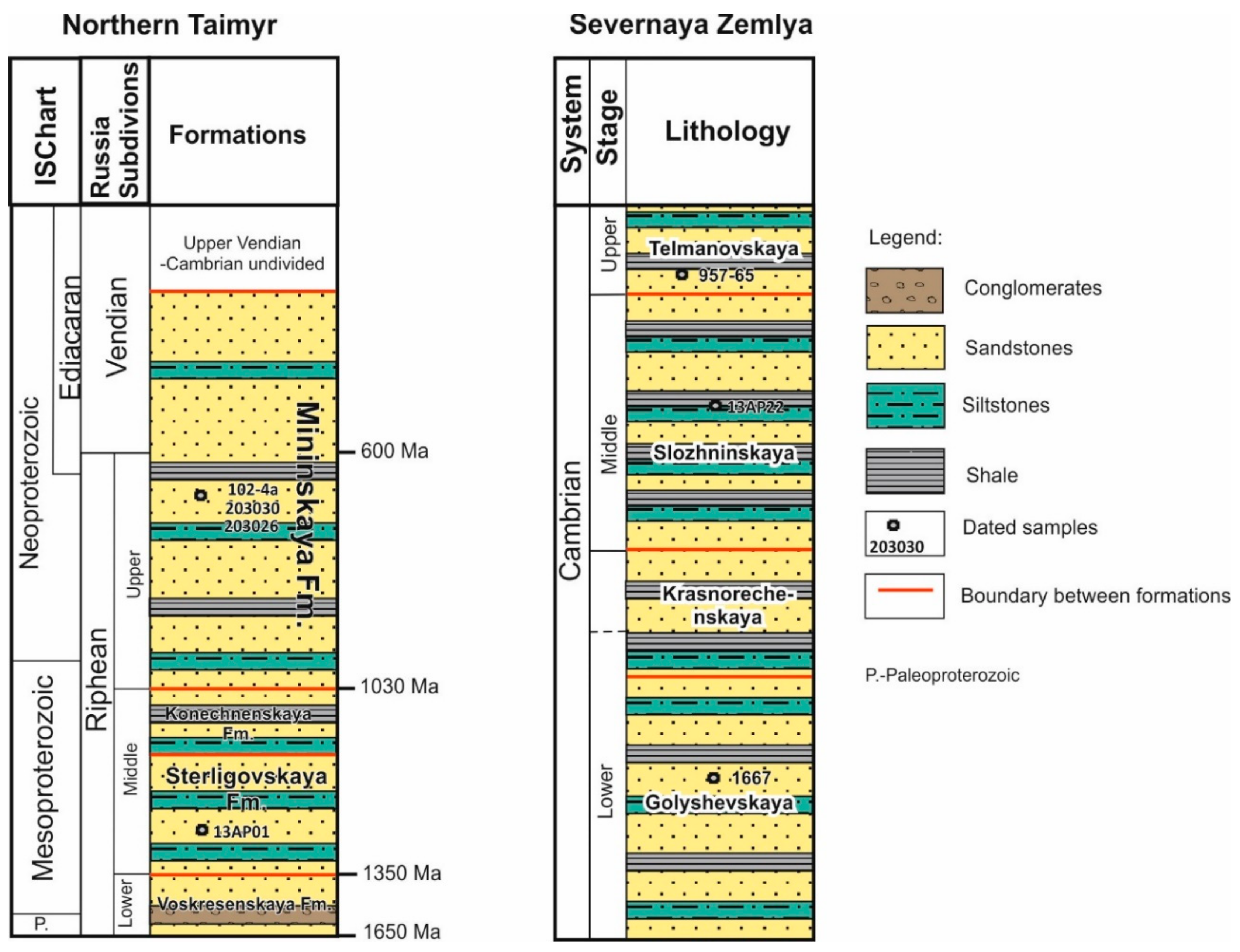
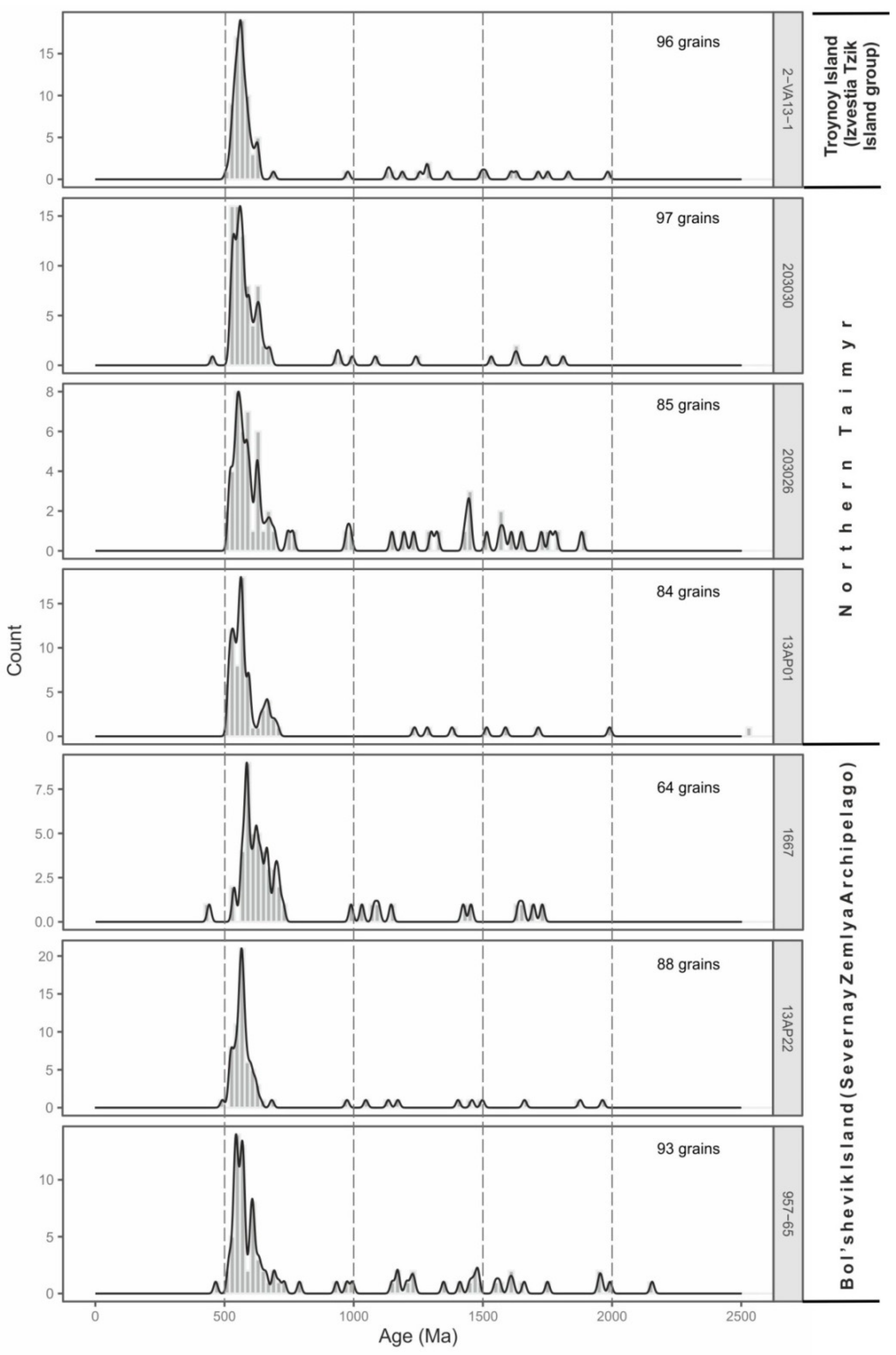
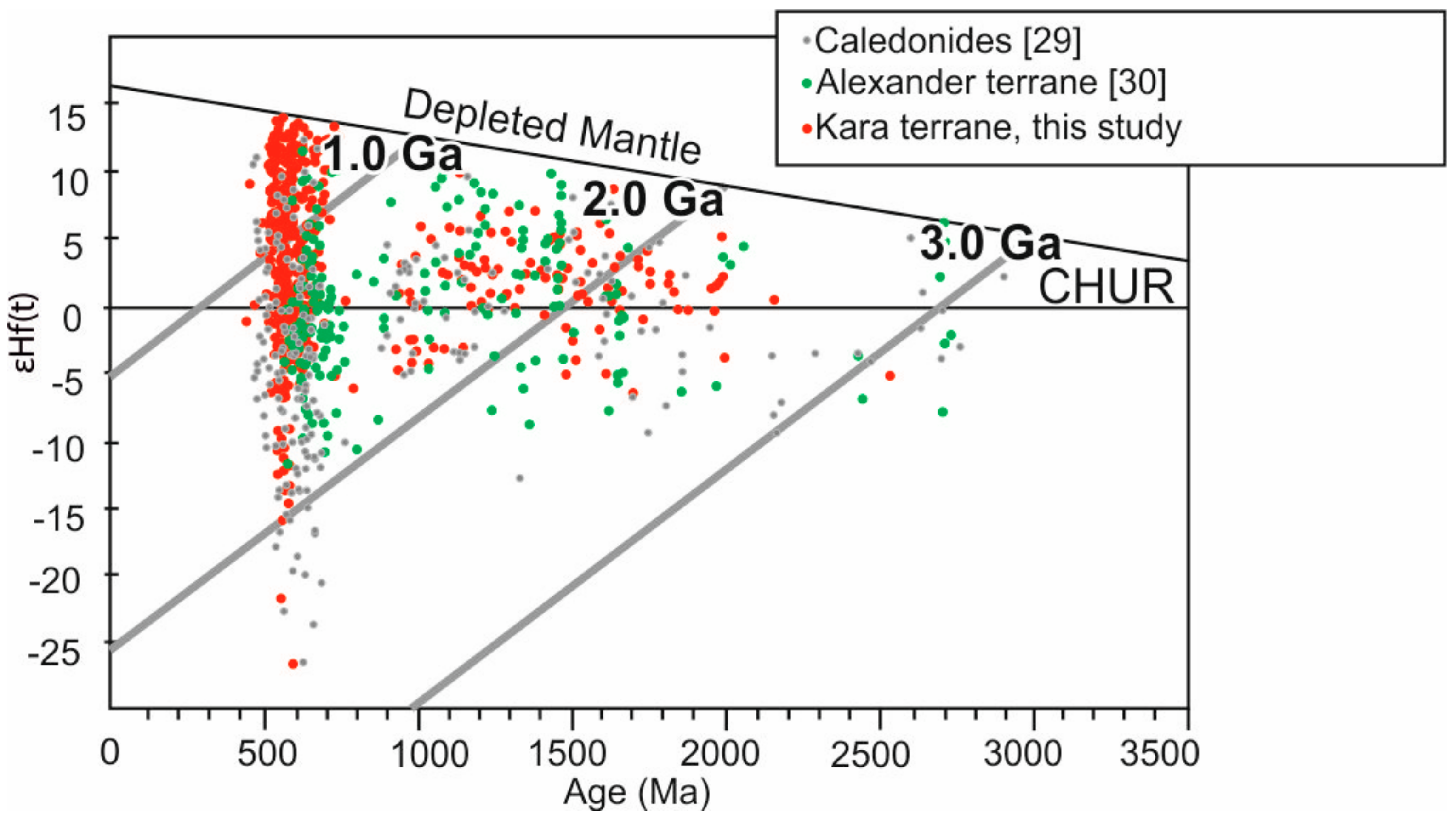

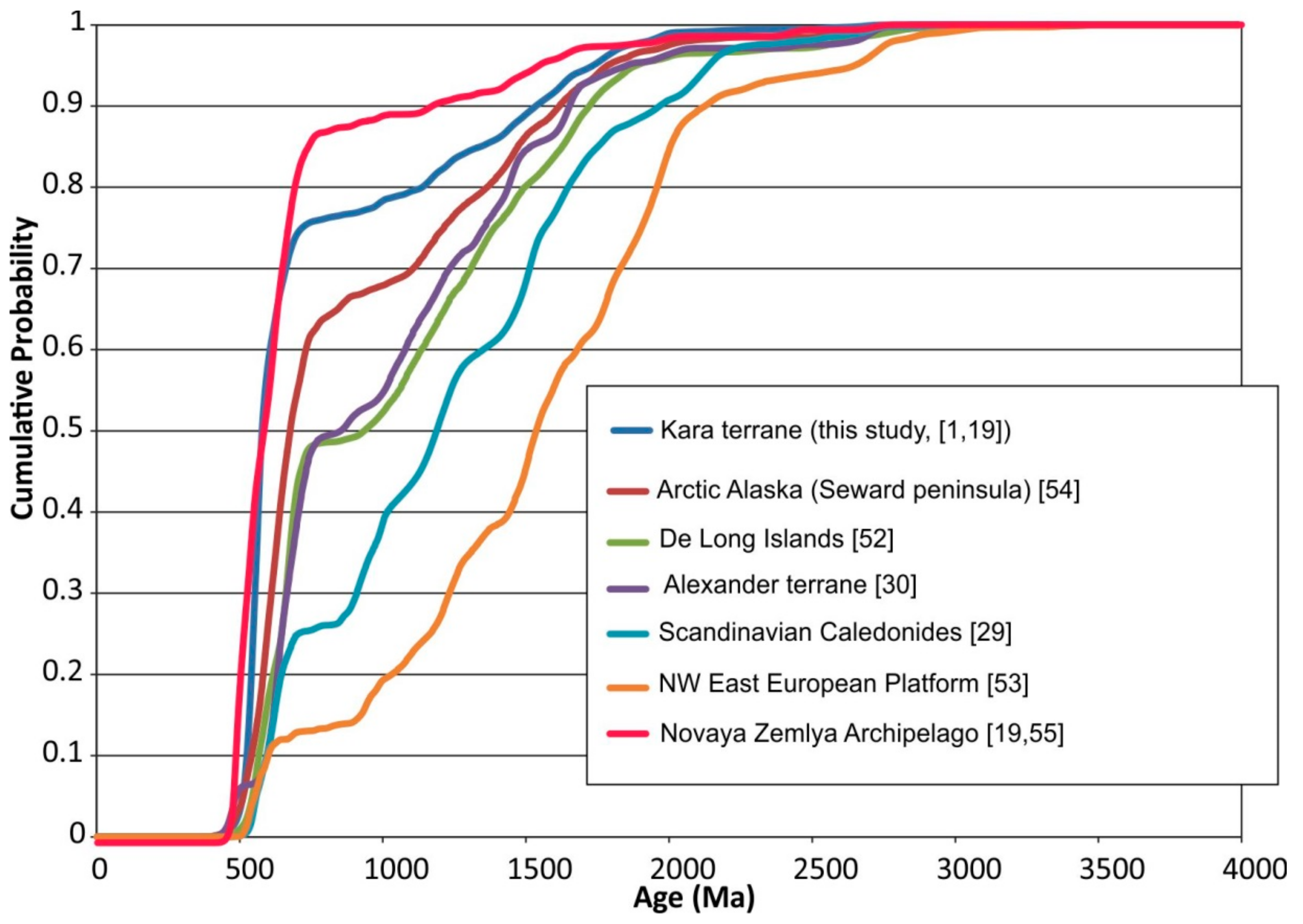
© 2019 by the authors. Licensee MDPI, Basel, Switzerland. This article is an open access article distributed under the terms and conditions of the Creative Commons Attribution (CC BY) license (http://creativecommons.org/licenses/by/4.0/).
Share and Cite
Ershova, V.B.; Prokopiev, A.V.; Khudoley, A.K.; Andersen, T.; Kullerud, K.; Kolchanov, D.A. U–Pb Age and Hf Isotope Geochemistry of Detrital Zircons from Cambrian Sandstones of the Severnaya Zemlya Archipelago and Northern Taimyr (Russian High Arctic). Minerals 2020, 10, 36. https://doi.org/10.3390/min10010036
Ershova VB, Prokopiev AV, Khudoley AK, Andersen T, Kullerud K, Kolchanov DA. U–Pb Age and Hf Isotope Geochemistry of Detrital Zircons from Cambrian Sandstones of the Severnaya Zemlya Archipelago and Northern Taimyr (Russian High Arctic). Minerals. 2020; 10(1):36. https://doi.org/10.3390/min10010036
Chicago/Turabian StyleErshova, Victoria B., Andrei V. Prokopiev, Andrey K. Khudoley, Tom Andersen, Kåre Kullerud, and Daniil A. Kolchanov. 2020. "U–Pb Age and Hf Isotope Geochemistry of Detrital Zircons from Cambrian Sandstones of the Severnaya Zemlya Archipelago and Northern Taimyr (Russian High Arctic)" Minerals 10, no. 1: 36. https://doi.org/10.3390/min10010036
APA StyleErshova, V. B., Prokopiev, A. V., Khudoley, A. K., Andersen, T., Kullerud, K., & Kolchanov, D. A. (2020). U–Pb Age and Hf Isotope Geochemistry of Detrital Zircons from Cambrian Sandstones of the Severnaya Zemlya Archipelago and Northern Taimyr (Russian High Arctic). Minerals, 10(1), 36. https://doi.org/10.3390/min10010036




